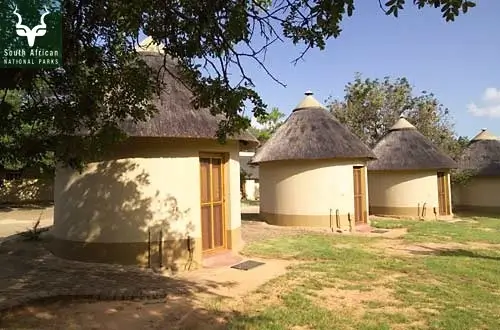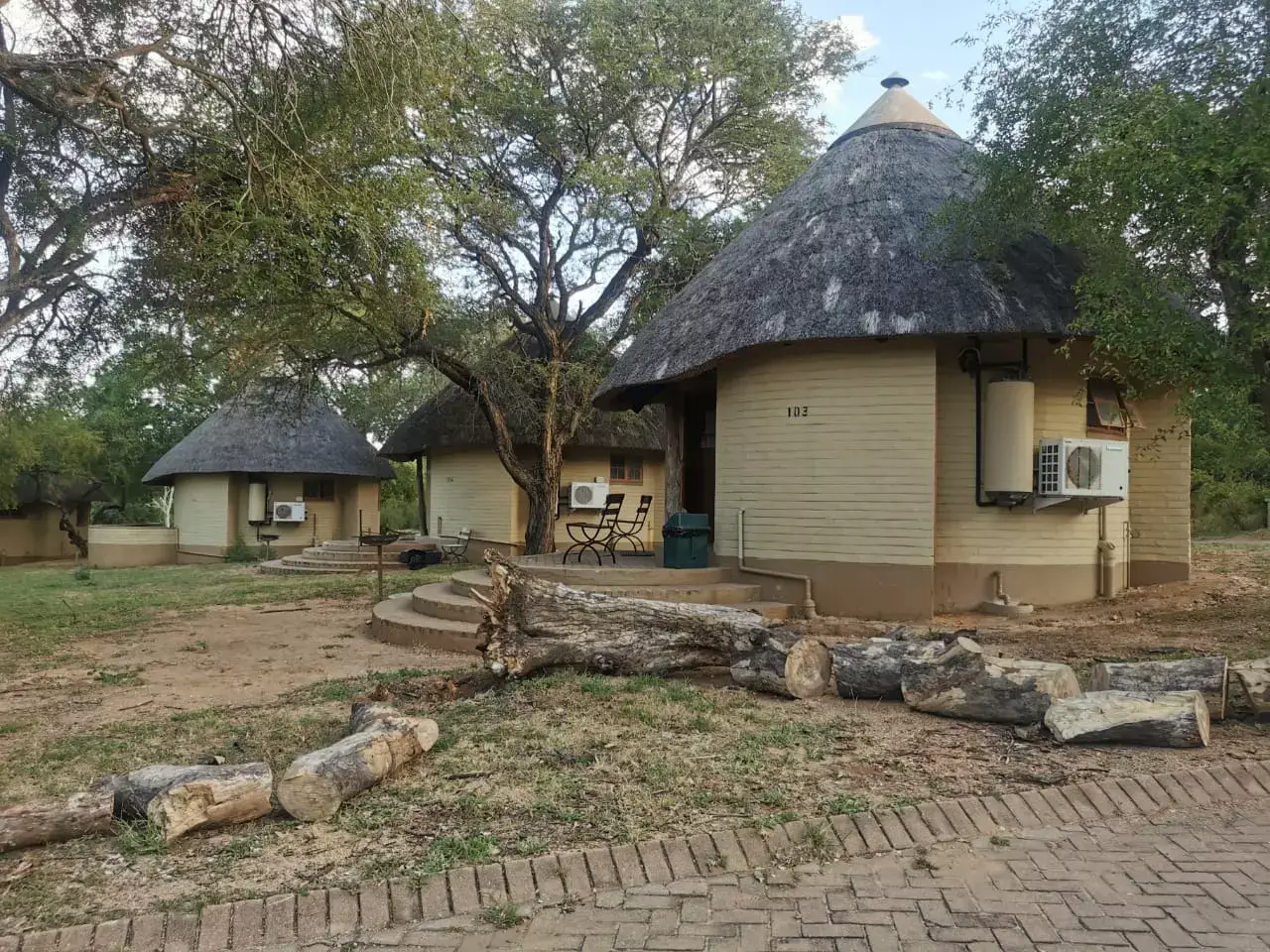Kruger National Park, South Africa’s premier wildlife sanctuary, captivates visitors with its diverse ecosystems and abundant wildlife. Spanning nearly 20,000 square kilometers, Kruger is one of Africa’s largest game reserves, offering unparalleled opportunities for adventure and wildlife observation. Its vast landscape is a mixture of savannah, woodlands, and riverine forests, creating a rich tapestry of life that enthralls nature enthusiasts and photographers alike.
Home to the "Big Five" — lions, leopards, elephants, rhinos, and buffalos — Kruger is a bucket-list destination for wildlife lovers. Beyond these iconic species, the park hosts over 500 bird species and dozens of other mammals, reptiles, and insects, ensuring every safari drive brings new discoveries.
Kruger’s allure extends beyond its fauna. The park boasts historical and cultural sites, where travelers can explore San rock art, ancient archaeological sites, and tales of early human settlement. Its extensive network of well-maintained roads and tracks makes it accessible for self-drive expeditions, while guided tours offer insights from experienced rangers.
Ease of access from major cities like Johannesburg and its array of accommodations — from luxury lodges to budget-friendly camping — makes Kruger an ideal destination for both short getaways and extended adventures. Whether you’re a seasoned safari-goer or a first-time visitor, the magic of Kruger National Park promises an unforgettable journey into the heart of the African wilderness.
Visitors often wonder how many days are enough to experience Kruger National Park fully. While there's no one-size-fits-all answer, most travelers find that a stay of 3 to 5 days strikes the perfect balance. During this timeframe, you’ll have ample opportunity to explore various parts of the park, encounter a wide range of wildlife, and soak in the incredible landscapes and experiences Kruger has to offer.
A shorter visit, such as 2 days, can still be rewarding but might feel rushed. You may only get a glimpse of the park's diverse ecosystems and iconic animals, such as lions, elephants, and rhinos. On the other hand, spending an entire week or more allows for a deeper dive into lesser-known areas and potentially spotting rarer species, but might not fit into everyone’s schedule or budget.
Kruger National Park spans nearly 20,000 square kilometers, so distributing your visit over multiple days ensures a more relaxing exploration. You can dedicate time to self-drive safaris, guided tours, and even specialized activities like bird-watching and night drives. This extended stay also allows flexibility in case of unpredictable weather or unforeseen delays.
Ultimately, your ideal stay depends on your interests, time constraints, and travel objectives. However, for a balanced itinerary that maximizes wildlife sightings and provides a well-rounded experience of Kruger National Park, aim for at least a 3-to-5-day visit. This duration offers the best chance to immerse yourself in the park’s natural beauty and varied wildlife without feeling too overwhelmed or pressed for time.

Exploring Kruger's Wildlife: Must-See Animals
Visiting Kruger National Park offers a rich, unforgettable wildlife experience, making it a top destination for nature enthusiasts and photographers. The park is renowned for its incredible biodiversity, featuring a vast array of mammals, birds, reptiles, and more.
One of the primary attractions is the Big Five: lions, elephants, leopards, rhinoceroses, and buffaloes. These iconic animals are not only fascinating to observe but also offer thrilling sightings that make for memorable safari adventures.
Lions, often referred to as the "kings of the jungle," can be spotted lounging under the shade or prowling through the grasslands. Elephants, with their majestic presence, are a frequent sight near waterholes and rivers, splashing and socializing in herds. Leopards, though more elusive, are worth the patience; their solitary and stealthy nature makes any sighting particularly special.
Rhinos, both black and white, are critically endangered, adding a rare and poignant element to the experience of seeing them roam freely within the park. Buffalos, often seen in large herds, are impressive with their sheer size and formidable horns.
Beyond the Big Five, Kruger is home to cheetahs, giraffes, zebras, hippos, and diverse antelope species. Birdwatchers will be thrilled with the park's avian diversity, boasting over 500 bird species, including the stunning lilac-breasted roller and the mighty martial eagle.
Each visit to Kruger National Park is unique, with every game drive or bush walk unveiling new and exciting wildlife encounters, making it a bucket-list destination for anyone passionate about nature and adventure.
Accommodation Options: From Luxury to Budget-Friendly Suggestions
When planning your visit to Kruger National Park, accommodation options are plentiful, catering to a variety of tastes and budgets. Whether you seek lavish comfort or economical choices, Kruger offers something for everyone.
For a taste of opulence, consider staying at one of Kruger's private game lodges. Places like Sabi Sabi or Singita provide all-inclusive packages with gourmet dining, guided safaris, and plush accommodations that promise an unforgettable experience. These lodges are ideal for those looking to splurge and enjoy a luxurious, worry-free stay.
Mid-range travelers will find numerous options within the park itself. The Kruger rest camps, such as Skukuza, Lower Sabie, and Satara, offer comfortable bungalows, cottages, and safari tents. These camps are well-equipped and provide essential amenities, including dining facilities and shops. Staying at these rest camps allows you to be close to nature without breaking the bank.
Budget travelers are not left out, either. Kruger National Park offers basic, yet cozy accommodations like safari tents and huts. Camps like Pretoriuskop and Crocodile Bridge provide an affordable way to experience the park's beauty. Additionally, self-catering facilities are available, letting you cook your own meals and save on dining expenses.
No matter where you choose to stay, booking well in advance is crucial, especially during peak seasons. By selecting the right accommodation, you can enhance your Kruger adventure, ensuring a memorable and comfortable trip amidst the African wilderness.
Activities to Enhance Your Kruger Experience
Kruger National Park offers a wide array of activities that go beyond the traditional safari drive. To truly maximize your visit, consider these exciting options:
1. Guided Game Drives: While self-driving is popular, opting for a guided game drive can provide a richer experience. Expert guides know the park well and can spot elusive animals, enhancing your chances of seeing the Big Five.
2. Walking Safaris: For adventurous souls, a walking safari offers a unique perspective. Accompanied by an armed ranger, you'll explore the park on foot, learning about the smaller creatures and plant life that are often missed from a vehicle.
3. Bird Watching: Kruger is a birdwatcher's paradise, with over 500 species recorded. Binoculars in hand, head to bird hides and waterholes where you can quietly observe a diverse range of birds, from majestic eagles to colorful kingfishers.
4. Night Drives: Experience the park’s nocturnal magic through a night drive. Spotting creatures like hyenas, leopards, and various nocturnal birds under the African starlit sky is truly unforgettable.
5. Cultural Tours: Take a break from wildlife and delve into the rich local culture. Visit nearby villages to learn about the traditional way of life and enjoy authentic South African food.
6. Photographic Safaris: For photography enthusiasts, specialized photographic safaris provide the perfect opportunity to capture stunning wildlife images. These tours often include guidance on the best camera settings and techniques.
Engaging in these activities will not only broaden your understanding of Kruger’s diverse ecosystem but also create memories that last a lifetime.

Practical Tips for Planning Your Visit
Planning your visit to Kruger National Park can make or break your safari adventure. Here are some practical tips to ensure you make the most of your time.
1. Book Early: Kruger is a popular destination, so accommodation and guided tours often fill up quickly. Booking at least six months ahead is advisable, especially for prime seasons like December and June to August.
2. Choose the Right Time: The dry winter months (May to September) are ideal for game viewing. Water sources become scarce, making animals congregate at rivers and waterholes. The summer months can be hot and wet, which may hinder visibility but also bring lush scenery and migratory birds.
3. Rent a Suitable Vehicle: A 4x4 isn't necessary, but having a high-clearance vehicle can be beneficial for spotting wildlife from a distance. Self-driving through Kruger is an option, offering flexibility, but guided tours can provide deeper insights into the park’s ecosystem.
4. Pack Essentials: Don’t forget binoculars, a good camera, and appropriate clothing. Layered clothing works best to adapt to the weather changes from morning to night. Sunscreen, hats, and insect repellent are also must-haves.
5. Plan Your Routes: Kruger is massive, spanning nearly 20,000 square kilometers. Research and plan which sections of the park you’d like to focus on, whether it’s the lush southern part or the more remote north. Be aware of gate opening and closing times to avoid being locked out.
6. Follow Park Rules: For your safety and to protect wildlife, adhere to park regulations. Don’t exit your vehicle except in designated areas, stick to speed limits, and never feed the animals.
Being well-prepared will enhance your experience and help you fully appreciate the wonders of Kruger National Park.












代发外链 提权重点击找我;
游戏推广 游戏推广;
Fortune Tiger Fortune Tiger;
Fortune Tiger Slots Fortune…
谷歌马甲包/ 谷歌马甲包;
谷歌霸屏 谷歌霸屏;
מכונות ETPU מכונות ETPU;
;ماكينات اي تي بي…
آلات إي بي بي…
ETPU maşınları ETPU maşınları;
ETPUマシン ETPUマシン;
ETPU 기계 ETPU 기계;
google seo…
03topgame 03topgame;
gamesimes gamesimes;
Fortune Tiger…
Fortune Tiger…
Fortune Tiger…
EPS Machine…
EPS Machine…
seo seo;
betwin betwin;
777 777;
slots slots;
Fortune Tiger…
seo优化 SEO优化;
bet bet;
google seo google seo技术飞机TG-cheng716051;
03topgame 03topgame
gamesimes gamesimes;
Fortune Tiger Fortune Tiger;
Fortune Tiger Slots Fortune Tiger…
Fortune Tiger Fortune Tiger;
EPS машины EPS машины;
Fortune Tiger Fortune Tiger;
EPS Machine EPS Cutting Machine;
EPS Machine EPS and EPP…
EPP Machine EPP Shape Moulding…
EPS Machine EPS and EPP…
EPTU Machine ETPU Moulding Machine
EPS Machine EPS Cutting Machine;
google 优化 seo技术+jingcheng-seo.com+秒收录;
Fortune Tiger Fortune Tiger;
Fortune Tiger Fortune Tiger;
Fortune Tiger Fortune Tiger;
Fortune Tiger Slots Fortune…
站群/ 站群
gamesimes gamesimes;
03topgame 03topgame
EPS Machine EPS Cutting…
EPS Machine EPS and…
EPP Machine EPP Shape…
Fortune Tiger Fortune Tiger;
betwin betwin;
777 777;
slots slots;
Fortune Tiger Fortune Tiger;
google seo…
03topgame 03topgame;
gamesimes gamesimes;
Fortune Tiger…
Fortune Tiger…
Fortune Tiger…
EPS Machine…
EPS Machine…
seo seo;
betwin betwin;
777 777;
slots slots;
Fortune Tiger…
seo优化 SEO优化;
bet bet;